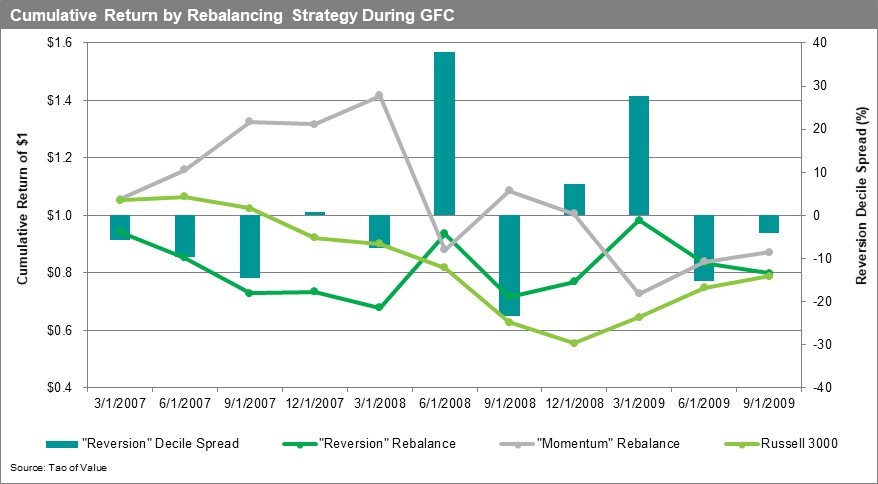Note: it’s separate post of same content from my 2020 Q1 letter. I attempted to use quantitative tools to review how different types of hypothetical “rebalancing” strategy would perform during the last market crisis.
It also relevant to revisit it as we may be thinking about whether we are at the same stage of June 2008 or March 2009.
During any crisis, investors like to talk about “rebalance”, value investors think it’s the time to sell names that dropped less and double down on the overreacted ones (let’s call it “reversion” rebalance), whereas growth investors think one should dump low quality which typically plummeted badly, for high quality ones which typically withhold better (let’s call it “momentum” rebalance).
To test which one worked better historically, I decided to backtest a 3-month momentum factor during the Great Financial Crisis (GFC). The basic idea can be explained as: I imagine different investors started to react at various points of time during the GFC and decided to rebalance based on past 3 months return. On Russell 3000 stock universe, we will slice all stocks up into 10 pieces (i.e. deciles) by ranking their past 3-months return, I ranked return ascendingly, so that decile 1 cam be defined as the losers (returned the worst), & decile 10 the winners (returned the best). Below is a snapshot of each decile’s forward 3 months return from various “reaction” time. For example, if an investor decided to buy the worst performing 10% stocks in past 3 months leading to 9/1/2008, he or she will suffer -41.97% in the next 3 months (from 9/1/2008 to 11/30/2008).

I see some noticeable observations:
- In the early part of the crisis, (from 200706 to 200712), losers kept losing and winners held up;
- During the first hit (from 200712 to 200803), names got hammered similarly across the row;
- From 200806 to 200809, the “reversion” rebalance immensely outperformed (on a spread of +38% 3 month forward return). Also note that D1 generated +14% (recover of overacted losers) & D10 suffered -24% (delayed punish for under-reacted winners)
- The following 3 month (200809 to 200812) witnessed the entire financial system melting down catalyzed by Lehman Brothers’ bankruptcy. We saw dark red (negative) returns across the row, and past losers were punished much worse than past winners (-42% D1 return vs. -19% D10 return)
- Starting from March 2009 (the trough), the market started to recover strongly. Surviving past losers started to outperform the less losers (D1 returned 64% in following 3 months), but not until it flipped in next 3 months.
Furthermore, at each point of time, a “reversion” rebalance could be constructed by buying the losers (D1) & shorting the winners (D10), vice versa for a “momentum” rebalance (buy D10 & short D1). If we calculate the spread between D1 & D10 (D1-D10 for “reversion” rebalance, and D10-D1 for “momentum” rebalance), we can see on cumulative basis, how each strategy may or may not add value for the most important task in a crisis – preserve capital. Below chart tells a very interesting story.

Note that the bar is the spread for “reversion” rebalance (i.e. D1 – D10), thus “momentum” rebalance would be simply the flip signed of such value. “Reversion” style tended to underperform in higher frequency (i.e. more occurrences), but when it reversed it tends to reverse drastically. This can be seen twice during 3 months after June 2008 (the bull trap) & March 2009 (the rebound after trough), which basically wiped out accumulated value from “momentum” rebalance completely. While you might think winning for one is losing for the other, both strategies (remind here they are market neutral) ended in red ($0.8 for “value” & $0.87 for “growth”). I also added the Russell 3000 index returns during same period as a reference of “do nothing” strategy, which ended at $0.8, on par with the “reversion” rebalancing strategy.
This study brought some very important insights for making decision during a crisis:
- Both rebalancing strategies work, yet in different phases of a crisis. Timing is crucial (as doing either way at the wrong time would heavily impair one’s capital), if you decide to rebalance. So think carefully whether you have good market timing skill before you act.
- Neither strategy could consistently add value for preserving capital purpose. I think it’s important that buy & sell decisions should still be made on absolute value vs. price basis, rather than on relative price movement basis.
- “Do nothing” is not as bad as you might think, especially when you know you can’t consistently time the market.
